
Positive results from the two-year data of high-risk Cohort A of the PARTNER trial a randomised comparison of patients treated with either surgical aortic valve implantation or the Edwards Sapien transcatheter heart valve have been published in The New England Journal of Medicine. The data were concurrently presented at the American College of Cardiology’s (ACC) 61st Annual Scientific Session in Chicago, USA.
At two years, all-cause mortality for patients treated with the Edwards Sapien transcatheter aortic valve implantation (TAVI) was 33.9%, which is statistically equivalent to open-heart surgical aortic valve replacement at 35.0%. Kodali S K et al concluded: “This two-year follow-up of patients in the PARTNER trial supports the use of TAVR as an alternative to surgery in selected high-risk patients with aortic stenosis. The two treatments were similar with respect to mortality, reduction in cardiac symptoms and improved valve hemodynamics.” The presentation also included available data out to 36 months, which trended similarly.
The authors noted that earlier results raised concerns that TAVI was responsible for increased early and, possibly, late strokes. However, data from the follow-up period of the PARTNER trial showed there was no significant difference in the risk of stroke between TAVI and surgery patients.
Predictors of mortality for the overall trial cohort, as well as for each of the randomised groups, were also analysed. The study authors noted that there was a new and important observation of an association of paravalvular regurgitation after TAVI with late mortality, possibly related to factors including the ratio of the transcatheter-valve size to the patient’s native valve size. According to the authors, “Recently, the routine use of three-dimensional imaging techniques has improved annulus sizing, resulting in better selection of properly sized valves.”
The PARTNER trial is the first randomised, controlled trial of a transcatheter aortic valve and the only trial that has follow-up data on all patients for at least two years. Cohort A of the trial enrolled between May 2007 and September 2009 and studied 699 patients with severe, symptomatic aortic stenosis deemed at high risk for traditional open-heart surgery. Patients were evaluated by a multi-disciplinary heart team and were evenly randomised to receive either traditional open-heart surgery or the Edwards Sapien valve with transfemoral or transapical delivery. The study represented the initial experience with TAVI at most sites, and the use of first-generation delivery systems. The PARTNER trial achieved its primary endpoint, concluding that survival of patients treated with the Sapien valve at one year was equivalent to those treated with surgery.
The two-year data from the inoperable Cohort B of the PARTNER trial were also published on 26 March in The New England Journal of Medicine. These data were previously presented in November 2011 at the Transcatheter Cardiovascular Therapeutics (TCT) scientific symposium.
The Edwards Sapien transcatheter heart valve received FDA approval for the treatment of certain inoperable patients and it is currently an investigational device for the treatment of high-risk patients in the USA. Following primary endpoint analysis, Edwards submitted one-year data from Cohort A of the PARTNER trial to the FDA in April 2011.













